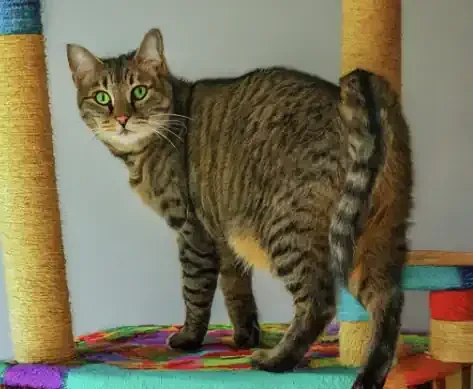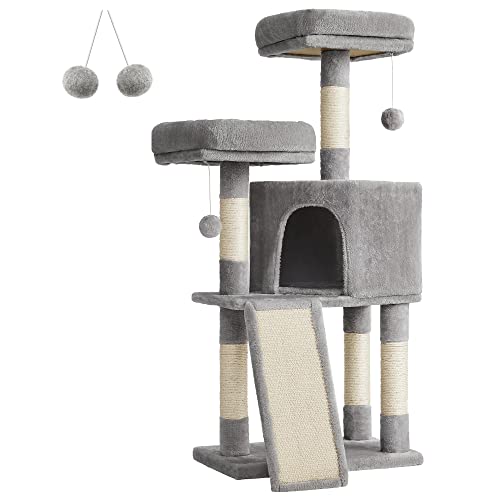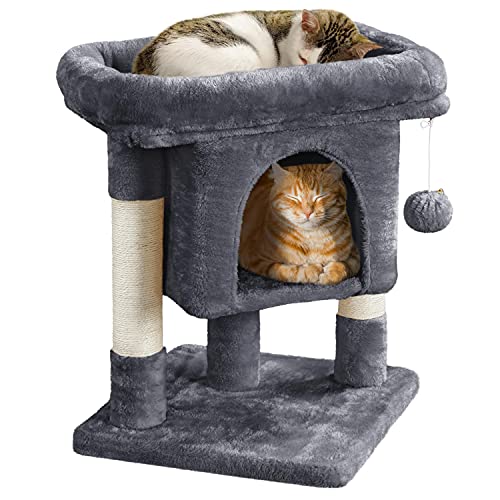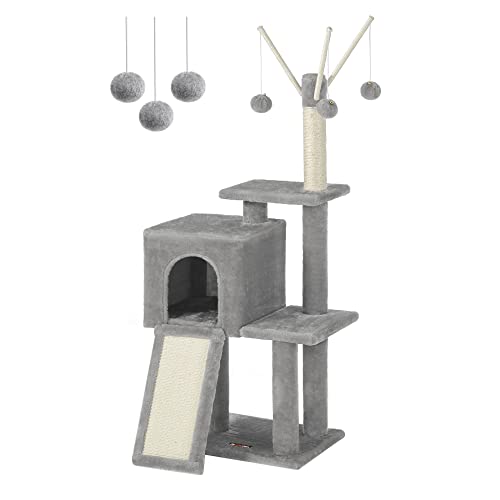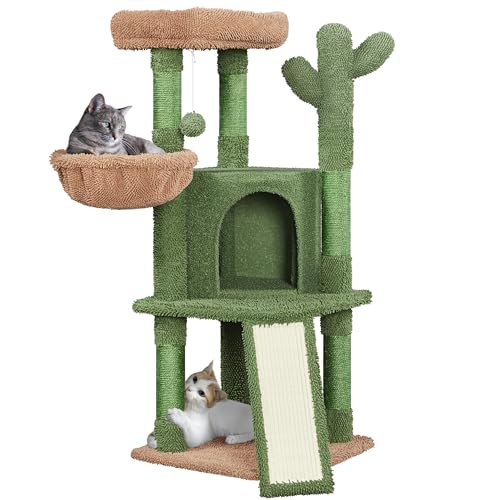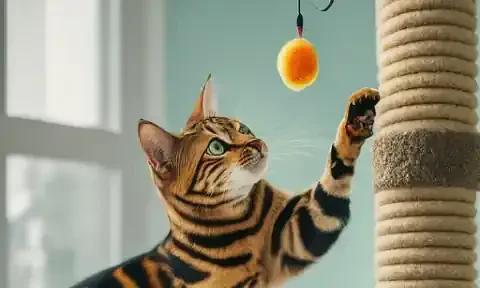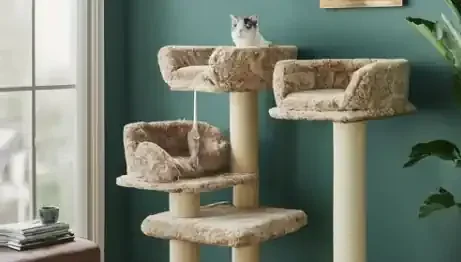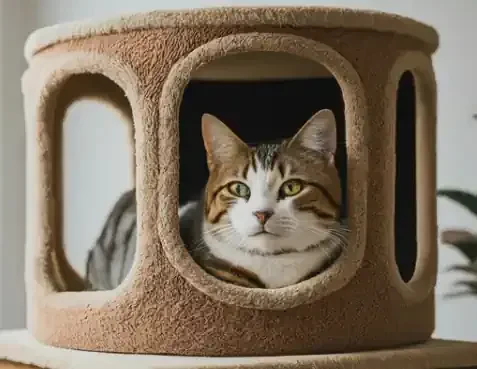Understanding Cat Tree Essentials: Size, Material, And Design Considerations
Choosing the perfect cat tree isn't just about aesthetics; it's about creating a safe and stimulating haven for your feline companion. Understanding the essentials—size, material, and design—is crucial for a purchase that satisfies both you and your cat.
Why Size Matters: Matching Your Cat's Needs
Cat trees come in a dizzying array of sizes, from compact towers for small spaces to sprawling cat condos fit for a king (or queen). Consider your cat's size, age, and activity level. A kitten might thrive on a smaller tree, while a large, energetic Maine Coon will need a taller, sturdier option to climb and stretch. Measure your available space to ensure the chosen tree fits comfortably without overwhelming the room.
Material Choices: Durability, Comfort, And Safety
Cat trees are typically constructed from wood, pressed wood, or cardboard. Wood offers the most durability and stability, especially for larger cats or those who love to climb. Pressed wood is a budget-friendly alternative, but may be less sturdy. Cardboard trees are lightweight and eco-friendly, but may not withstand enthusiastic scratching and play. Upholstery materials vary from plush carpet to faux fur, each offering different textures and comfort levels. Opt for materials that are easy to clean and maintain, as cat hair and occasional accidents are inevitable.
Design Preferences: Modern, Traditional, Or Whimsical?
Cat trees come in a wide range of designs to suit any taste. Sleek, modern trees blend seamlessly with contemporary decor, while traditional styles offer classic elegance. For those who love a touch of whimsy, cat trees shaped like castles, trees, or other fun objects are available. Consider your personal style and your cat's preferences. Do they prefer open perches or cozy hideaways? Choose a design that complements your home and provides the features your cat will love.
Must-Have Features: Scratching Posts, Perches, And Hiding Spots
Every cat tree should include a few essential features. Scratching posts are crucial for satisfying your cat's natural urge to scratch, protecting your furniture in the process. Sisal rope is a popular and durable scratching post material. Multiple perches at different heights provide opportunities for climbing, jumping, and observing their surroundings. Cozy hideaways, like enclosed condos or hammocks, offer a safe retreat for rest and relaxation. Some cat trees even include interactive toys or dangling objects to keep your cat entertained.
Navigating The World Of Cat Trees: Popular Types And Their Benefits
With a vast array of cat tree styles available, finding the right one can feel like navigating a jungle. But don't fret! This section explores the most popular types and their unique benefits, helping you pinpoint the perfect fit for your feline friend's personality and lifestyle.
Tall Cat Trees: Reaching New Heights
For the adventurous climber, tall cat trees offer a vertical playground that mimics their natural instinct to scale heights. These towering structures provide a sense of accomplishment and security, allowing cats to survey their territory from above. Tall cat trees often feature multiple scratching posts, dangling toys, and platforms at varying levels, encouraging exercise and mental stimulation.
Multi-Level Cat Condos: A Playground For Climbing And Exploring
Multi-level cat condos are like miniature gyms for your cat. They typically feature a combination of scratching posts, platforms, enclosed cubbies, and sometimes even tunnels or hanging toys. This variety of features caters to different feline preferences, offering ample opportunities for exercise, play, and relaxation. Multi-level condos are especially well-suited for households with multiple cats, providing distinct territories and reducing competition for resources.
Wall-Mounted Cat Trees: Space-Saving Solutions
If you're short on floor space but still want to provide your cat with a vertical haven, wall-mounted cat trees are a fantastic option. These ingenious designs attach directly to the wall, utilizing vertical space efficiently. They often feature staggered platforms, scratching posts, and even cozy hammocks or baskets, giving your cat a place to climb, play, and nap without sacrificing precious square footage.
Cat Trees With Hammocks: Cozy Retreats For Relaxing
Every cat deserves a comfy spot to curl up and nap. Cat trees with hammocks offer just that—a plush, suspended bed that sways gently with every movement, providing a soothing and secure resting place. Hammocks can be made from various materials, including plush fabric, faux fur, or even durable canvas. Some cat trees even feature multiple hammocks at different levels, offering a variety of napping spots to suit your cat's mood.
Window Perch Cat Trees: Birdwatching Bliss
For cats who love to gaze out the window and observe the world around them, window perch cat trees are a dream come true. These designs typically feature a sturdy platform that attaches securely to a window sill, allowing your cat to bask in the sunlight, enjoy the view, and indulge their natural hunting instincts by watching birds and squirrels. Some window perch cat trees even incorporate scratching posts or dangling toys to enhance the experience.
By understanding the diverse world of cat trees, you're one step closer to finding the ideal sanctuary for your beloved feline.
Safety First: Ensuring A Secure And Enjoyable Cat Tree Experience
Creating a safe haven for your feline friend goes beyond choosing an attractive cat tree. It's about prioritizing safety measures that protect your cat from harm and ensure a worry-free experience for both of you. Let's delve into the key factors for a secure and enjoyable cat tree experience.
Sturdy Construction: Avoiding Wobbles And Tipping
A stable cat tree is the foundation of feline safety. Look for solid construction with a wide base and a balanced design. Ensure that the materials used are durable and can withstand the weight and movements of your cat, especially during energetic play. Check for reinforcements and bracings, particularly in taller or multi-level models. Avoid flimsy or poorly constructed cat trees that might wobble, tip over, or collapse, posing a serious risk to your furry companion.
Non-Toxic Materials: Protecting Your Cat's Health
Your cat's health is paramount, so choose a cat tree made with non-toxic materials. Avoid those treated with harmful chemicals, such as formaldehyde, flame retardants, or heavy metals. Opt for natural or untreated wood, sisal rope, and fabrics that are safe for your cat to chew and scratch. Check for certifications like the OEKO-TEX Standard 100, which ensures that textiles are free from harmful substances.
Proper Placement: Stability And Accessibility
Where you place your cat tree can significantly impact its stability and your cat's enjoyment. Position it on a level surface, away from high-traffic areas, to minimize the risk of accidental bumps or collisions. Ensure that the cat tree is easily accessible for your cat, with steps or ramps that are not too steep or slippery. If your cat has any mobility issues, opt for a design with lower platforms and gentle inclines.
Regular Inspection: Identifying Wear And Tear
Cat trees are subject to wear and tear over time, so regular inspection is essential. Check for loose screws, frayed ropes, or damaged platforms. Tighten any loose parts and replace worn components promptly to maintain safety and functionality. Inspect scratching posts for signs of excessive wear and replace them if needed to encourage continued use and discourage scratching on your furniture.
Secure Attachments: Anchoring To Walls Or Ceilings
For tall or top-heavy cat trees, consider anchoring them to walls or ceilings for added stability. Use appropriate hardware and follow the manufacturer's instructions for secure installation. This extra precaution prevents accidental tipping and ensures your cat's safety during enthusiastic climbing and jumping.
By prioritizing safety, you can transform your cat tree into a haven of fun and relaxation, providing peace of mind for both you and your beloved feline companion.
Matching Your Cat Tree To Your Cat's Personality And Lifestyle
Just as humans have unique personalities and preferences, so do our feline companions. Selecting a cat tree that aligns with your cat's individual traits and lifestyle ensures maximum enjoyment and utilization. Let's explore how to find the perfect match for your furry friend.
Active Cats: Playful Designs With Plenty Of Activity Options
If your cat is a bundle of energy, always on the move and seeking adventure, a cat tree with plenty of interactive elements is a must. Look for designs that incorporate dangling toys, tunnels, and scratching posts with different textures. Consider a taller tree with multiple platforms to encourage climbing and exploration. A cat tree with built-in toys or those that allow you to easily add your own will provide endless entertainment for your active feline.
Shy Cats: Cozy Hideaways And Secluded Spaces
For the more reserved or timid cat, a cat tree that offers a sense of security and privacy is key. Look for designs with enclosed cubbies, covered perches, or hammocks where your cat can retreat and observe their surroundings without feeling exposed. Soft, plush materials and quiet corners will appeal to their desire for a peaceful sanctuary. Consider a cat tree with multiple hiding spots to give them options for different moods and times of day.
Senior Cats: Easy-To-Climb Ramps And Platforms
Older cats may have decreased mobility or joint pain, so a cat tree that prioritizes accessibility is essential. Look for designs with gentle ramps or steps instead of ladders, as well as wide, sturdy platforms that are easy to navigate. Consider a lower cat tree or condo to minimize the need for jumping. Soft, cushioned surfaces can provide extra comfort for aging joints. Always consult your veterinarian for guidance on choosing a cat tree that supports your senior cat's specific needs.
Multiple Cats: Spacious Trees With Room For Everyone
In a multi-cat household, it's important to provide ample space for each cat to have their own territory and avoid conflict. Choose a spacious cat tree with multiple perches, platforms, and hiding spots distributed across different levels. This allows each cat to have their own designated space while still enjoying the benefits of a shared environment. Consider placing multiple cat trees or scratching posts throughout your home to further reduce competition and ensure everyone has a place to play and relax.
Scratching Preferences: Sisal, Carpet, Or Other Materials
Cats have individual preferences when it comes to scratching surfaces. Some love the rough texture of sisal rope, while others prefer the softness of carpet or fabric. Observe your cat's scratching habits and choose a cat tree that includes their preferred material. Some cat trees offer a variety of scratching surfaces, catering to different preferences and encouraging your cat to use the tree instead of your furniture.
By understanding your cat's unique personality and lifestyle, you can select a cat tree that not only enhances their physical and mental well-being but also becomes their favorite place to play, relax, and feel safe.
Budget-Friendly Options: DIY Cat Trees And Affordable Alternatives
Furnishing your feline's domain doesn't have to break the bank. With a little creativity and resourcefulness, you can create or find budget-friendly cat trees that offer both functionality and style. Let's explore some options to make your cat happy without emptying your wallet.
Upcycling Furniture: Repurposing Old Shelves Or Bookcases
Before you toss out that old bookcase or set of shelves, consider giving them a new life as a cat tree. With some simple modifications, these sturdy pieces can be transformed into climbing structures that your cat will adore. Add platforms made from scrap wood, secure sisal rope to the legs for scratching, and hang toys or hammocks from the shelves. Not only is this a sustainable option, but it also adds a unique and personalized touch to your cat's furniture.
Building From Scratch: Step-By-Step Instructions And Plans
If you're handy with tools, building a cat tree from scratch can be a rewarding and cost-effective project. Numerous online resources offer free plans and tutorials for DIY cat trees, catering to various skill levels and budgets. Start with simple designs using readily available materials like wood planks, sisal rope, and carpet remnants. As you gain experience, you can explore more elaborate designs with additional features like tunnels, bridges, or hanging baskets.
Affordable Store-Bought Options: Finding Value For Your Money
If DIY isn't your forte, don't despair! There are plenty of affordable cat trees available in stores and online. Look for sales, discounts, or clearance items to snag a good deal. Consider purchasing a smaller tree or a basic model with fewer features to save money. Remember that a simple cat tree can be just as enjoyable for your cat as a more elaborate one, as long as it provides the essentials: a place to climb, scratch, and rest.
Creative Alternatives: Using Trees, Branches, And Cardboard
Nature provides a wealth of materials that can be repurposed into cat furniture. Sturdy tree branches, securely mounted to a base, can become a natural climbing structure. Cardboard boxes, stacked and connected with tunnels, create a playful and stimulating environment. Old ladders, wrapped in sisal rope or carpet, can be transformed into scratching posts. With a little imagination, you can turn everyday objects into functional and engaging cat furniture.
Incorporating Existing Cat Furniture: Integrating With Your Current Setup
If you already have some cat furniture, don't feel obligated to replace it entirely. Instead, consider incorporating it into your new setup. Combine a tall scratching post with a DIY platform or add a hammock to an existing condo. This approach not only saves money but also allows you to create a unique and personalized play area for your cat.
Remember, the goal is to provide a safe and enjoyable environment for your cat without overspending. With some creativity and resourcefulness, you can create or find budget-friendly cat trees that your feline friend will love.
Maintenance And Care Tips: Keeping Your Cat Tree Clean And Inviting
A well-maintained cat tree isn't just about aesthetics; it's about hygiene, longevity, and keeping your feline friend happy and healthy. Proper care ensures that your cat's favorite perch remains a safe and inviting haven for years to come. Let's explore the essential maintenance tips for a clean and well-maintained cat tree.
Cleaning Schedules: Removing Hair, Dirt, And Debris
Cat trees are magnets for fur, dust, and other debris. Establish a regular cleaning schedule to keep your cat tree fresh and hygienic. Frequent vacuuming or brushing can remove loose hair and prevent buildup. Pay special attention to crevices, corners, and fabric surfaces where dirt tends to accumulate. For deeper cleaning, consider using a pet-safe upholstery cleaner or a mixture of water and mild detergent. Always follow the manufacturer's instructions for cleaning specific materials.
Safe Cleaning Products: Avoiding Harsh Chemicals
When cleaning your cat tree, opt for natural or pet-safe products that won't harm your cat's health or sensitive skin. Avoid harsh chemicals like bleach, ammonia, or strong fragrances, as these can irritate your cat's respiratory system and cause skin allergies. Instead, choose gentle cleaners specifically formulated for pet use or create your own using natural ingredients like vinegar, baking soda, or essential oils (diluted in water).
Dealing With Stains And Odors: Natural Solutions
Accidents happen, and your cat tree might occasionally encounter stains or unpleasant odors. Fortunately, natural solutions can effectively tackle these issues. For urine stains, a mixture of vinegar and water can neutralize odors and disinfect the area. Baking soda can be sprinkled on fabric surfaces to absorb odors, then vacuumed away. Essential oils like lavender or citrus can also be used to freshen up the cat tree, but be sure to dilute them properly and avoid applying them directly to areas where your cat might come into contact with them.
Protecting From Pests: Preventing Fleas And Mites
Fleas and mites can quickly infest a cat tree, causing discomfort for your furry friend and potential health issues. Regular cleaning helps deter these pests, but additional measures can be taken. Vacuuming thoroughly, including crevices and corners, removes eggs and larvae. Wash removable covers and bedding in hot water. Consider using a pet-safe flea and tick spray or powder to further protect the cat tree from infestations.
Replacing Worn Parts: Maintaining Safety And Function
Over time, parts of your cat tree may become worn or damaged. Fraying sisal rope, loose screws, or broken platforms can pose safety risks and detract from your cat's enjoyment. Regularly inspect your cat tree for signs of wear and tear, and replace any damaged components promptly. This not only ensures your cat's safety but also prolongs the lifespan of the cat tree, saving you money in the long run.
By following these maintenance and care tips, you can keep your cat tree clean, safe, and inviting for years to come, providing your feline companion with a comfortable and enjoyable space to play, rest, and thrive.
Top Cat Tree Brands And Where To Find Them: Online And In-Store Options
Choosing the right cat tree brand can make a significant difference in quality, durability, and overall feline satisfaction. This section explores some of the top brands known for their craftsmanship, design, and commitment to feline well-being, along with the best places to find them.
Popular Brands: Trusted Names In Cat Furniture
Go Pet Club: Renowned for its wide range of cat trees catering to various budgets and preferences, Go Pet Club offers sturdy construction, multiple scratching posts, and plenty of platforms for climbing and playing.
Frisco: Chewy's in-house brand, Frisco, boasts affordable cat trees with a focus on functionality and fun. They offer a variety of sizes and styles, including tall towers, multi-level condos, and even trees with built-in scratching posts and toys.
Armarkat: This brand specializes in premium cat trees crafted from solid wood, known for their durability and stylish designs. Armarkat offers a variety of models to suit different needs and preferences, including options for large cats, multiple cats, and cats who love to scratch.
Mau Lifestyle: If you're looking for a modern and minimalist aesthetic, Mau Lifestyle cat trees are a great choice. Their sleek designs blend seamlessly with contemporary decor, and they prioritize quality materials and craftsmanship.
Tuft + Paw: For those who appreciate design-forward cat furniture, Tuft + Paw offers elegant and functional cat trees that double as works of art. Their pieces are crafted with high-quality materials and focus on both feline enjoyment and home decor integration.
Online Retailers: Convenient Shopping And Reviews
Chewy: A popular choice for pet supplies, Chewy offers a wide selection of cat trees from various brands, including their own Frisco line. Their detailed product descriptions and customer reviews make it easy to compare options and find the perfect fit.
Amazon: With its vast marketplace, Amazon offers a diverse range of cat trees from both established and emerging brands. You can filter by price, size, features, and customer ratings to narrow down your choices.
Wayfair: This online retailer is a treasure trove of home decor and furniture, including a substantial selection of cat trees. Their filter options and curated collections make it easy to browse and discover unique designs.
Local Pet Stores: Personalized Service And Expertise
Visiting your local pet store can provide a more personalized shopping experience. Knowledgeable staff can offer recommendations based on your cat's specific needs and preferences. You can also physically inspect the cat trees to assess their quality and ensure they meet your expectations.
Specialty Cat Boutiques: Unique And High-End Options
If you're looking for something truly unique and luxurious, specialty cat boutiques offer a curated selection of high-end cat trees from independent designers and craftsmen. These boutiques often showcase innovative designs and focus on quality materials and craftsmanship.
Secondhand Marketplaces: Finding Deals And Unique Pieces
For budget-conscious shoppers or those seeking one-of-a-kind finds, secondhand marketplaces like Craigslist, Facebook Marketplace, or local thrift stores can be a goldmine. You might find gently used cat trees at a fraction of the price of new ones. However, be sure to inspect them thoroughly for any damage or wear before purchasing.
Summary
Choosing the perfect cat tree involves understanding your cat's individual needs and preferences. Factors like size, material, and design play a crucial role in creating a safe and stimulating environment for your feline friend.
Size: Consider your cat's size, age, and activity level when choosing a cat tree. A larger, more active cat will need a taller and sturdier tree, while a smaller or older cat may be content with a compact model.
Material: Opt for durable and safe materials like wood, sisal rope, and non-toxic fabrics. Choose upholstery that is easy to clean and maintain.
Design: Select a design that complements your home décor and caters to your cat's preferences. Some cats prefer open perches, while others seek cozy hideaways.
Must-Have Features: Ensure the cat tree includes essential features like scratching posts, multiple perches, and hiding spots. These features cater to your cat's natural instincts and provide opportunities for exercise, play, and relaxation.
Choosing the right cat tree is an investment in your cat's well-being. By considering their unique needs and preferences, you can create a haven that they'll love and cherish for years to come.
